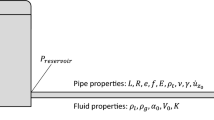Conclusions
-
1.
The introduction into design practice of computer calculations of transients led, on one hand, to an increase of possibilities for analyzing various operating regimes of surge tanks, including those which investigators have lost sight of, and, on the other hand, required considerable expansion of the volume of data characterizing the operation of conduits, branches, and local resistances.
-
2.
The developed method permits analytic determination of the relationship between the specific energies of flows in the fork of a tank in the complete range of its operating regimes. In this case two values of the resistance coefficient are used, one of which is determined with respect to the regime of the entry of the total flow from the diversion into the tank and the second with respect to the entry of the total flow from the tank into the diversion.
-
3.
As a result of analyzing Soviet and foreign data of investigations of the hydraulics of forks [3, 4, 5] it was established that the resistance coefficient of a transition between a tank and conduits is composed of a constant component which depends on the geometry of the transition and a variable component determined by the relationship of discharges in the branches.
-
4.
The use of the proposed analytic relations in calculating transitions on a computer increase the quality of modeling and reliability of the results obtained.
Similar content being viewed by others
Literature cited
P. G. Kiselev (ed.), Handbook of Hydraulic Calculations [in Russian], Énergiya, Moscow (1972).
V. A. Orlov, Surge Tanks of Hydroelectric Stations [in Russian], Énergiya, Moscow (1968).
I. E. Idel'chik, Handbook on Hydraulic Resistances [in Russian], Mashinostroenie, Moscow (1975).
G. I. Krivchenio, I. S. Ivanov, and A. P. Mordasov, Pressure Conduits of Hydroelectric and Pumping Stations [in Russian], Énergiya, Moscow (1969).
A. Gardel and G. F. Rechsteiner, “Des pertes de charge dans les branchements en bé des conduits de section circulaire,” Bulletin Technique de la Suisse Romande, 96 (1970).
Additional information
Translated from Gidrotekhnicheskoe Stroltel'stvo, No. 3, pp. 10–14, March, 1984.
Rights and permissions
About this article
Cite this article
Arshenevskii, N.N., Berlin, V.V. & Murav'ev, O.A. Mathematical modeling of hydraulic regimes in the transition between the surge tank and conduits of a hydroelectric station. Hydrotechnical Construction 18, 105–110 (1984). https://doi.org/10.1007/BF01428698
Issue Date:
DOI: https://doi.org/10.1007/BF01428698




